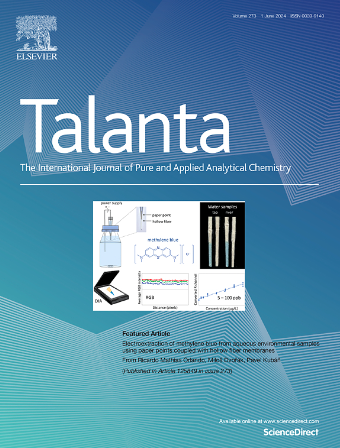Ionic liquid-assisted synthesis of In2O3 nanoparticles for ultra-fast detection of unsymmetrical dimethylhydrazine
IF 5.6
1区 化学
Q1 CHEMISTRY, ANALYTICAL
引用次数: 0
Abstract
Due to the unique physiochemical properties of ionic liquids, they are extensively used as agent or solvent in the synthesis process of nanomaterials. The tailored growth process of functional nanomaterials might result in performance modification for them. In this work, In2O3 nanoparticles were prepared via the hydrothermal method and subsequent calcination (400 °C, 500 °C, 600 °C and 700 °C). An ionic liquid (1-hexadecyl-3-methylimidazolium chloride, [C16Mim] Cl) was introduced in the hydrothermal process. After calcination, trace of [C16Mim] Cl inclusion in In2O3 was pyrolyzed with Cl residue (Cl–In2O3). In compare with control sample synthesized without [C16Mim] Cl (pure In2O3), In2O3-600 (Cl–In2O3 calcined at 600 °C) exhibited an excellent UDMH sensing performance at 225 °C. The fabricated sensor achieved a high response value (71.0 ± 2.1 to 100 ppm), rapid response time (2 s), good selectivity and a low theoretical limit of detection (1.72 ppb) to UDMH gas. Various characterizations, in regard to oxygen vacancy, surface texture structure, energy band structure and surface acidity, were utilized to analyze the cause for enhanced performance. The ionic liquid inclusion increases the contents of adsorbed oxygen species and improves the adsorption capacity to UDMH gas. This work indicates that the synthesized In2O3 nanoparticles could be the potential candidates for rapid UDMH detection in some specific application scenarios.

求助全文
约1分钟内获得全文
求助全文
来源期刊

Talanta
化学-分析化学
CiteScore
12.30
自引率
4.90%
发文量
861
审稿时长
29 days
期刊介绍:
Talanta provides a forum for the publication of original research papers, short communications, and critical reviews in all branches of pure and applied analytical chemistry. Papers are evaluated based on established guidelines, including the fundamental nature of the study, scientific novelty, substantial improvement or advantage over existing technology or methods, and demonstrated analytical applicability. Original research papers on fundamental studies, and on novel sensor and instrumentation developments, are encouraged. Novel or improved applications in areas such as clinical and biological chemistry, environmental analysis, geochemistry, materials science and engineering, and analytical platforms for omics development are welcome.
Analytical performance of methods should be determined, including interference and matrix effects, and methods should be validated by comparison with a standard method, or analysis of a certified reference material. Simple spiking recoveries may not be sufficient. The developed method should especially comprise information on selectivity, sensitivity, detection limits, accuracy, and reliability. However, applying official validation or robustness studies to a routine method or technique does not necessarily constitute novelty. Proper statistical treatment of the data should be provided. Relevant literature should be cited, including related publications by the authors, and authors should discuss how their proposed methodology compares with previously reported methods.
 求助内容:
求助内容: 应助结果提醒方式:
应助结果提醒方式:


